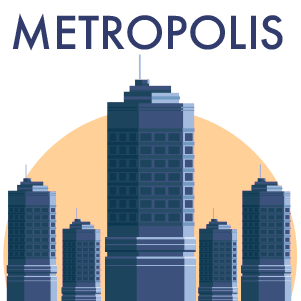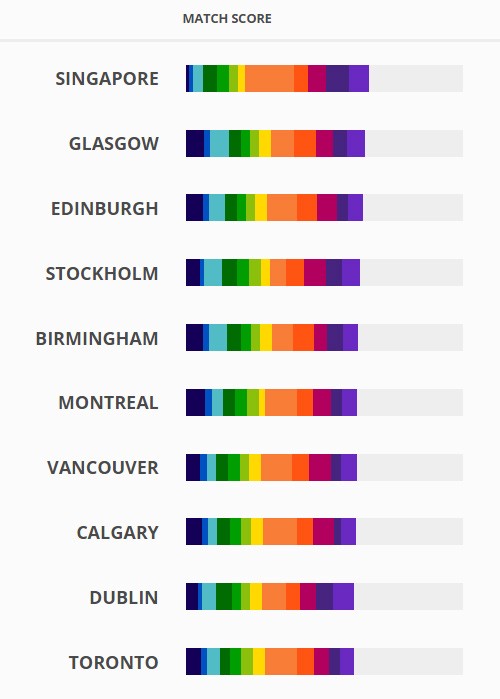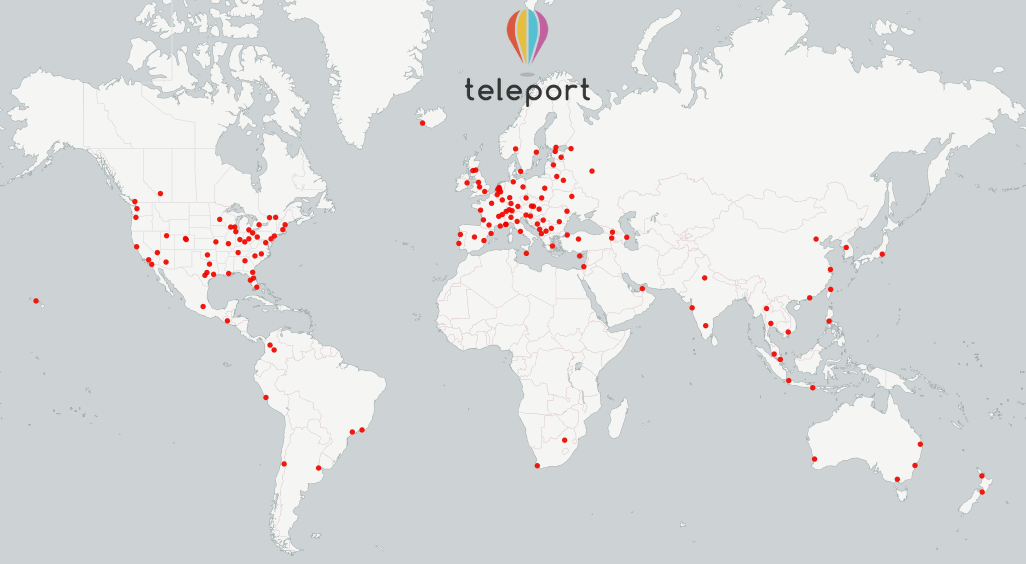

“Number one is lack of pollution. Number two is physical safety, lack of crime, or low crime. Number three is a tolerant society. Number four is rental cost.”
That’s Sten Tamkivi talking about the priorities people have when picking a new city to move to. He’s an Estonian entrepreneur and the creator of a company called Teleport that purports to help people move to their “best place to live and work.”
“People very often think that budgetary things matter, but the top three are not financial,” Tamkivi said. “They’re much more about the softer side of life, and being safe and being tolerated. The last thing you want to do is go somewhere where you get harassed for your skin color or whatnot.”
On Teleport’s website, after a short sign-up process, you’ll find a questionnaire that ranks more than 250 different cities in terms of how well they’re likely to suit you. It’s surprisingly detailed–you can tweak it for personal preferences related to climate, education, safety, language, job market, taxes, pollution, and even traffic. What’s more, if you specify your monthly rent and salary, you’ll be shown how much more disposable income you’ll have in different cities around the world. The company earns its money by helping to facilitate that move–putting you in touch with local contacts and services to make the transition easier.

At the top of my chart was Singapore, which was a bit of a surprise because I indicated that I like the weather in Stockholm and was expecting rather chillier locations as a result. Singapore’s high scores in internet access, safety, and environmental quality–which are also important to me–seemed to have trumped its humid climate.
Singapore was followed by Glasgow, Edinburgh, and Stockholm, which were less of a surprise given the city I actually live in–Gothenburg, on Sweden’s west coast, which wasn’t even up for consideration.
I moved from London to Gothenburg about three and a half years ago to get a master’s degree. I’m still not totally sure if I moved so that I could study, or if I signed up for the degree program so I could move. Either way, it’s great and I love it–Gothenburg is small enough to easily navigate on public transport, filled with parks and green spaces, accessible to most of Europe and, despite its small size in comparison to many cities, there’s always something going on. Living here feels like a perpetual holiday: It’s the perfect place for me.
But I recognize that having the freedom to decide to live elsewhere is a massive privilege. I had the money, familial support, career flexibility, and passport power to uproot myself from London and relocate to Gothenburg. A young woman living in a slum in Nairobi has none of those things. The vast majority of people in the world have none of those things, and many of them are forced to move anyway.
Think about this subject for too long, and it’s hard to escape the conclusion that the practice of “digital nomads” moving from the West to cheaper cities in developing nations (I’m not including Gothenburg here, of course) is essentially just a form of global gentrification. These knowledge workers push up local prices, drive longtime residents out of fashionable neighborhoods, and rarely engage in any meaningful way with the local culture and community. This has its troubling historical parallels with colonialism, too–particularly in Asia.
While knowledge workers usually end up paying more in taxes than permanent residents because their salaries are higher, that only benefits the local economy if the workers are actually registered for taxes, and if corruption isn’t a thing (which it unavoidably is in much of the developing world). And while the presence of digital nomads in a city tends to correlate with a reasonable local startup scene, any wealth generated often fails to trickle down to the people who need it the most.

Tamkivi admits that many of the core users of Teleport are rather alike–they’re white, male, from comfortable backgrounds, and work in the software industry. But he also recognizes that this crowd isn’t enough to sustain the company long term and is actively working to broaden the user base.
That base expanded somewhat following the Paris attacks in late 2015–when the company noticed a spike in registrations on the site, driven by some coverage in the French media. “I saw that these were completely a different set than the ones that we’d been attracting before,” said Tamkivi. “There was a significant share of users whose job type was “‘other.’ Since then, we’ve added 20 or 30 new job categories just to be more accommodating. Even if we’re not optimized for finding a job for a medical nurse today, we at least know that they are there and learn about them.”
Teleport also noticed a jump in the number of retirees interested in the service. “You already know what the assets are, how much money you have in the pension fund, whether you own a house,” Tamkivi said. “You don’t have any of the dependencies, like kids and schools and all that. You have some new requirements–maybe a hospital nearby and good healthcare. Maybe [you] don’t want to be more than a three-hour flight from [your] grandchildren.”

What Teleport doesn’t do–yet–is let you move outside of a city. That’s probably because, with few exceptions, the world’s rural areas don’t have the infrastructure that knowledge workers demand. Chiefly, that’s a fast internet connection, but it also includes good access to transport hubs and spaces where people can meet and exchange ideas. “There are benefits of co-living and cohabitation,” said Tamkivi.
But technology rolls inexorably onward, and as a result it’s hard to see physical cities–at least in their current form–avoiding an eventual extinction. As super fast broadband spreads beyond the edges of our towns, and virtual reality technology develops, our cities will lose their place on the map and become instead grounded in digital communities. It may already be happening–who are you closer to, your neighbors or your Facebook friends?
“If you get to VR that actually works, and brain implants that can transmit stuff on your iris directly, the borderline gets fuzzier,” Tamkivi said, when asked if the traditional city is the final form of human organization. “There’s the uncanny valley of whether [virtual reality] is close enough, but at some point, it will be. I’m not sure that for everything humankind will figure out in the next few hundred years the city is the best answer.”


How We Get To Next was a magazine that explored the future of science, technology, and culture from 2014 to 2019. This article is part of our Metropolis section, on the way cities influence new ideas–and how new ideas change city life. Click the logo to read more.
